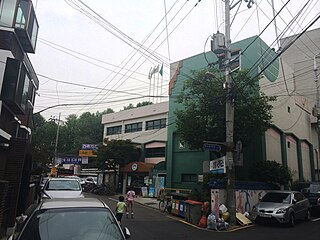Related Research Articles

Sogong-dong is a dong of Jung-gu district in Seoul, South Korea.
Mukjeong-dong is a legal dong, or neighbourhood of the Jung-gu district in Seoul, South Korea and governed by its administrative dong, Jangchung-dong.
Namgajwa-dong is a dong, neighbourhood of Seodaemun-gu in Seoul, South Korea.
Seogang-dong is a legal dong, neighbourhood of the Mapo-gu district in Seoul, South Korea.
Sangsu-dong is a legal dong, neighbourhood of the Mapo-gu district in Seoul, South Korea and was merged with Changjeon-dong into Seogang-dong in January 2007.
Sangam-dong is a legal dong (neighborhood) of the Mapo District in Seoul, South Korea. In the wake of the 2002 FIFA World Cup, a large apartment complex and DMC business district have been created and developed into the center of western Seoul.

Dohwa-dong is a dong (neighborhood) of Mapo District, Seoul, South Korea.

Hapjeong-dong is a dong (neighborhood) of Mapo District, Seoul, South Korea.
Jung-dong is a dong, neighbourhood of the Mapo-gu district in Seoul, South Korea.

Mangwon-dong is a dong, or neighbourhood of the Mapo-gu district in Seoul, South Korea.
Mapo-dong is a dong, neighbourhood of the Mapo-gu district in Seoul, South Korea.
Nogosan-dong is a dong, neighbourhood of the Mapo-gu district in Seoul, South Korea.
Seogyo-dong is a dong, or neighbourhood, of the Mapo-gu district in Seoul, South Korea.
Seongsan-dong is a dong, neighbourhood of the Mapo-gu district in Seoul, South Korea.
Singongdeok-dong is a dong, neighbourhood of the Mapo-gu district in Seoul, South Korea.
Sinjeong-dong is a dong, neighbourhood of the Mapo-gu district in Seoul, South Korea.
Sinsu-dong is a dong, neighbourhood of the Mapo-gu district in Seoul, South Korea.
Tojeong-dong is a dong, neighbourhood of the Mapo-gu district in Seoul, South Korea.
Yeomni-dong is a dong or neighbourhood of the Mapo-gu district in Seoul, South Korea.
Yeonnam-dong is a dong, neighbourhood of the Mapo-gu district in Seoul, South Korea. The neighbourhood that was once simply a home to locals, has now emerged into a trendy location for many aspiring artists and designers. As more unique shops and cafes began to fill the streets and alleyways, the area gradually became a very popular area for young university students and tourists. The most popular attraction in Yeonnam-dong is Gyeongui Line Forest Park where the Gyeongui Line train formerly ran before it was moved underground.
References
- 1 2 "용강동 (Yonggang-dong 龍江洞)" (in Korean). Doosan Encyclopedia . Retrieved 2008-05-11.
- ↑ "The origin of the dong' name (Yonggang-dong 용강동)" (in Korean). Mapo-gu official site. Retrieved 2008-05-11.
- "Chronicle of Beopjeong-dong and Haengjeong-dong" (in Korean). Guro-gu Official website.
- "Mapo Information". The chart of legal dong assigned by administrative dong (행정동별 관할 법정동 일람표) (in Korean). Mapo-gu Official website.
